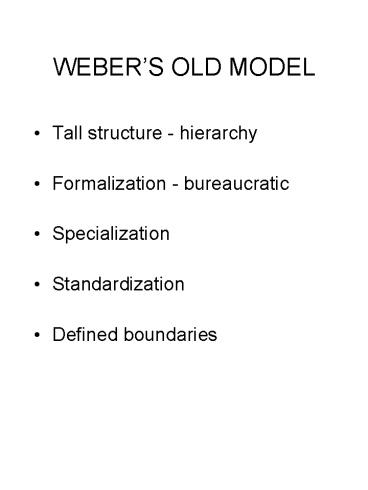WEBERS OLD MODEL - PowerPoint PPT Presentation
1 / 5
Title:
WEBERS OLD MODEL
Description:
WEBER'S OLD MODEL. Tall structure - hierarchy. Formalization - bureaucratic. Specialization ... past behavior/policies/performance of the organization. RESOURCES ... – PowerPoint PPT presentation
Number of Views:33
Avg rating:3.0/5.0
Title: WEBERS OLD MODEL
1
WEBERS OLD MODEL
- Tall structure - hierarchy
- Formalization - bureaucratic
- Specialization
- Standardization
- Defined boundaries
2
NEW ORGANIZATIONALMODEL
- Flat
- Networked
- Flexible
- Diverse
- Global
3
INPUTS
- HISTORY - past behavior/policies/performance of
the organization - RESOURCES - tangible assets such as human
resources, technology, plant equipment,
capital - intangible assets such as
recognition/reputation - ENVIRONMENT - the current context the
organization operates in - competitors,
suppliers, customers, interest groups - macro
factors such as national culture, national and
global business trends (e.g., recession) - STRATEGY - missions, goals and objectives for
organizations performance
4
TRANSFORMATION PROCESStools the org. uses to
transform inputs into effective performance in
org/groups/individuals
FORMAL ORGANIZATION - explicit, codified
aspects of the organization - structure,
formal processes, systems (e.g., pay
systems control systems, information systems)
INFORMAL ORGANIZATION - implicit, assumed,
unwritten aspects - culture, leadership,
group dynamics, communication patterns
PEOPLE - characteristics of individual
members of the org - personality/job fit,
motivations, decision making TASK -
characteristics of work/jobs - workflow,
knowledge requirements, time demands
5
OUTPUTSwhat the organization produces, how it
performs/effectiveness
ORGANIZATIONAL LEVEL - goal attainment -
resource utilization - flexibility/adaptability
GROUP LEVEL - cohesion, integration -
contribution to organization-level
objectives INDIVIDUAL LEVEL - satisfaction,
stress, quality of work life































